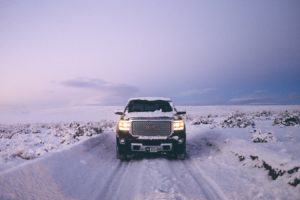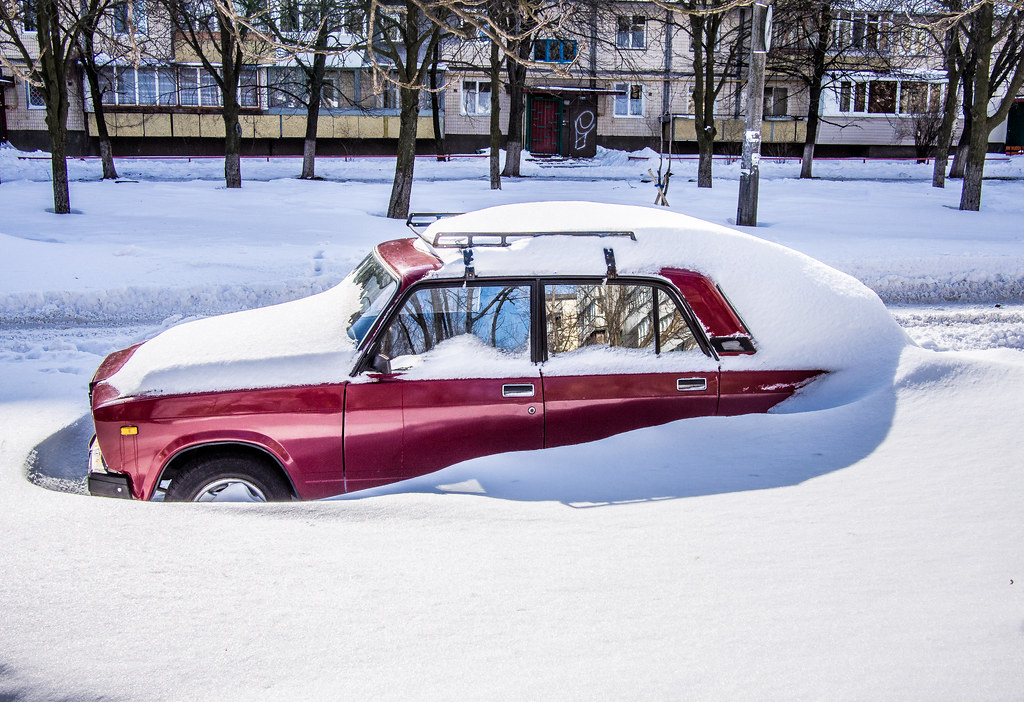Winter Driving Tips: Learn How to Drive Safe in the Winter
December 30th, 2019 by Danelle Conlon

Winter is upon us and comes along with unpredictable driving conditions, slick roads and difficult visibility.
Winter driving is something all commuters dread. Approximately 800 Americans per year are killed in winter related auto accidents, with most of those fatalities in the Northeast and Great Lakes states.
Driving in cold weather is a useful skill, but many drivers aren’t accustomed to navigating roadways, or they aren’t aware of winter driving safety. With that in mind, the collision repair specialists here at Fix Auto put together some winter driving safety recommendations for driving in cold weather. We’ve certainly witnessed our share of fender benders and accidents through the years. And we know how driving in extreme cold and winter driving can negatively impact road safety.
Winter driving is especially dangerous if you’re only used to driving in picture-perfect conditions. San Diegan’s, for example, aren’t likely prepared for getting stuck in a winter snowstorm or driving on icy roads, which can go from dangerous to fatal in an instant. Being knowledgeable about driving in cold weather will help prevent accidents, injuries, or worse.
This winter driving guide will review some effective winter driving skills, different tools to take along during winter driving, things to understand about your own vehicle, how to handle accidents, and much more.
When There’s Snow Just Go Slow
Speed kills. That’s a simple fact for many car accidents. Speed + snow is an even more hazardous equation. Snow-covered roads are responsible for a significant portion of those yearly winter accidents we discussed earlier. If you want to learn how to drive in snow, just remember to go slow. Many winter-related automobile accidents are preventable. Excessive speed or even just normal speed is a major factor in many collisions.
Driving in snow requires patience, persistence, and plenty of awareness. Mother Nature is ultimately in control when winter weather is in full swing. However, that doesn’t mean drivers have no control over their safety. There are a few tried and true methods for safely driving in snow. Most are common sense techniques, while others are specific to winter weather conditions. In particular, we recommend the following tips for driving in snow:
Winter Driving Tips
1. “Start” off on the right foot
How to start your car in the cold is an underrated aspect of safe winter driving. Before starting the engine, ensure all of your powered accessories (radio, defrost, interior lights, etc.) are turned off. This allows all available power to be directed from the battery to the starter while starting the engine. In cold weather, this step is important to help get your engine running. If the car doesn’t start in less than 10 seconds, wait 20-30 seconds before trying again; this gives the starter mechanism enough time to cool down after the first attempt. Before turning the key, wait until your vehicle dashboard lights (oil, engine, and related indicators) to turn off. Electronic fuel-injected cars can adjust the air to fuel ratio in the engine, based on the outside temperature. Once the car starts, adjust the airflow mode to recirculate, as this helps to warm your car faster (as opposed to pulling in air from the outside of the car). Turn on your front and rear defroster. Don’t turn on the windshield wipers until the defrost has removed excess snow or ice. Allow your car to idle for a few minutes before putting the car in drive.
2. Test the road conditions first
Let’s say you’re leaving the grocery store and it’s starting to snow. It’s always a good idea to test traction before you head out on the road. Find an empty section of the parking lot, and sharply apply your brakes with no cars around on flat, even ground. This small “terrain test” will give you a better idea of what conditions are like once you’re out on the roads with other cars
3. Slow down
This one is so important, it bears repeating. Maintain a safe, reasonable speed in snowy conditions. Don’t try to approach posted speed limits on your snow-covered commute; those are for perfect driving conditions. If the speed limit is 45 MPH, and you’re safe going half that speed (or less), that’s fine.
4. Shift toward safety
In other words, use your vehicle’s transmission to increase safety when driving in snow. If you’re driving an automatic, utilize a lower gear, or turn off overdrive (usually indicated by “O/D OFF”) to reduce your car’s max driving speed. For manual transmissions, staying in second or third gear is an excellent idea.
5. Watch your following time
When the roads are dry, it’s fine to give the car ahead of you a 2-3 second following distance. For snow and ice, the American Automobile Association (AAA) recommends at least 5-6 seconds of following time to account for longer stops. Many drivers use the 8-10 second following rule, which gives you even more time to react to constantly changing driving conditions.
TIP: Using a marker such as a bridge or road sign, count the seconds from the moment the car in front of you passes the marker until you arrive to determine your distance.
6. Use extra caution on hills, around bends, and intersections.
In an ideal world, winter driving wouldn’t involve stopping your vehicle. You can avoid stopping completely by gently slowing your car before you arrive to a red light, allowing it time to turn green to avoid coming to a complete stop. The same goes for hills and inclines. Stopping on a steep hill sometimes is the difference between getting a tow and making it home. Sometimes, winter driving conditions demand a full stop. Slow down around sharp bends, don’t over accelerate going up hills, and give yourself plenty of time to stop around intersections.
7. Steer wisely
If your rear wheels start to lose control when driving in snow, steer into the skid and apply gentle pressure to the gas pedal. This will help you regain control of your car quicker. Even though your basic instinct would be to slam the brakes, don’t! This only increases the chances of a rollover or totally losing control of your car. This is an extremely important collision fact to be aware of. For understeers (when your front tires start to slip in ice or snow), remove your foot from the gas pedal and straighten the steering wheel until your tires grip the road.
Remember, when temperatures start to fall, rainy conditions can rapidly switch over to heavy snowstorms. Keep an eye on your car’s exterior temperature indicator (if you have one), and stay alert for weather updates with local radio stations. Need to check your phone for a quick weather assessment? Only view your phone when you’re completely pulled over and in park.
Accessorize for Winter Driving: Tools to Boost Safety on the Roads
Like any other activity, winter driving is easier when you have the right safe-driving tools and apps along for the ride. Winter driving is the ultimate unpredictable environment; everything is OK one minute, then you’re on the wrong side of the road the next. You never know when an accident or slide-off-the-road can occur. That’s why it’s important to accessorize the right way for winter driving. Let’s take a look at some tools to help you optimize your winter driving safety.

Winter Driving Tools
1. Snow chains for tires
Some drivers can’t drive in the snow without snow chains, while others use regular snow tires for winter driving. The snow tires vs chains debate is one of those issues with fervent adherents on both sides. Much like Burger King vs McDonald’s and Coke vs Pepsi, the decision between snow tires vs chains comes down to personal preference. One thing is for sure: despite massive technological advancements in automotive technology, there are few better ways to “get a grip” on snowy wintry streets than a good set of snow chains for your tires. Snow chains come in two major configurations: z-chain and radial chain. If you prefer driving with snow chains, make sure they’re installed correctly; a set of snow chains for tires not applied the right way can not only damage your tires – it can also jeopardize safety.
2. Car cover for snow
For drivers without a garage or covered carport, a car cover is the next best option. This accessory helps protect your vehicle’s exterior during those dreary winter months, and also reduces the wear and tear associated with constant scraping, brushing, etc. If you use a car cover for snow, use one that wraps partially under your car, with secure ties to prevent strong winds from blowing off the cover.
3. Car snow shovel
Anyone who has driven in the snow long enough – despite using safe driving methods and taking extra precautions – inevitably needs a good car snow shovel to get back on the road. A small, compact shovel in the trunk is helpful in a pinch. If you have to shovel yourself out of a snowdrift or ditch, apply the parking brake before venturing outside.
4. Bag of sand
Snowy, icy roads make it difficult for tires to grip the road, especially on the shoulder of a highway or off the road. This causes a similar effect to not taking care of your worn-out tires. Even with a car snow shovel, getting back on the road is difficult or impossible without enough friction for your tires to spin. Spread some sand on the road next to your tires to provide enough “grab and go” traction!
5. Jumper cables
Cold weather is hard on car batteries. Keep a clean, easy accessible pair of jumper cables in your car just in case you (or a fellow commuter) needs a jump. To jump a dead battery, make sure both cars have the ignition off. Clamp the positive (red +) end of one cable to the positive terminal of the dead battery. Next, take the other end of the cables and clamp the positive (red +) and negative (black -) ends of the cable to the matching terminals on the good battery. Finally, clamp the negative (black -) end of the remaining cable end to a stable piece of metal in the dead car’s engine. Start the car with the good battery, let the car idle a few minutes, then attempt to start the dead car. Once the car starts, remove the cable clamps in the reverse order they were installed.
6. Flares
In case of an accident, flares alert oncoming drivers. Keep a working set of at least 5-6 flares in your car. Even if you’re not involved in a winter driving accident, you can use the flares to assist other drivers.
7. Extra fluids
Keep additional antifreeze, brake fluid, windshield washer fluid and oil in your car. Of course, you should regularly check all engine fluids and the windshield fluid on a regular basis; but cold weather driving is hard on engines (and wipers), so it’s helpful to have some extra fluids along for the ride.
8. Snow/ice scraper
Snow and ice scrapers are a very versatile tool to have in your winter driving arsenal. They come in different sizes and are able to fit in various parts of your car such as the glove box, trunk & under the seat. Whatever you choose, it is important for your safety and the safety of others to clear ice and snow off your windshield and mirrors.
Aside from these items, keep these basic tools and accessories on hand:
- Lug nut wrench
- Jack
- Socket set
- Screwdriver
- Hammer
- Crowbar
- Spare tire
Before You Go in the Snow: Why Extra Car Knowledge is Critical for Safe Winter Driving
What temperature does gasoline freeze? How often should you start your car in the cold? How can you keep a car battery warm in cold weather? All of these (and more) are important questions to ask before you have to answer them. It all starts with basic knowledge about your car.
When it comes to driving in the snow, knowledge is power. The more you know about weather conditions and how to react during every situation helps keep your car on the road. And the more you know about your car also helps, especially in terms of performance and your car’s ability to drive in the snow.

Winter Driving FAQS
Here are some FAQs about winter driving that can prevent accidents:
Q: What temperature does gasoline freeze?
A: Contrary to popular belief, gas doesn’t freeze the same temperature as water. Most gasoline blends (octane 87, 89, 91 and 93) freeze at around -40 to -50 degrees Fahrenheit. Can gasoline freeze? Only in the most bitter winter climates; for most of the United States, drivers don’t have to worry about this.
Q: Can my car be too cold to start?
A: If there is water in your fuel line, or the temperature is cold enough to slow your car battery’s chemical reactions, yes. Cold weather and car batteries aren’t an ideal mix; to keep a car battery warm in cold weather, start your car at least once every few days when temperatures are below freezing. If you’ve ever wondered how often you should start your car in the cold, follow the daily temperature – hour equation. For example, if the average temperature is around 30 degrees, start your car roughly every 30 hours.
Q: Can a car battery freeze?
A: The battery itself can’t freeze, but the components inside can be stunted due to extremely cold weather. Once a car battery is “drained” from cold weather, a jump start (see above) is recommended.
Q: Which car performance features can help with winter driving?
A: Anti-lock brakes are recommended (thankfully, most modern cars have anti-lock brakes). Don’t remove your foot off the brake in vehicles with anti-lock brakes. If your car doesn’t have anti-lock brakes, apply steady, even pressure to the brake pedal, and repeat as necessary. Electronic stability control (ESC) helps during skids; this feature controls the steering wheel to prevent wipeouts and tip-overs. If your vehicle has all-wheel drive (AWD), you’re in luck; AWD provides superior traction in a variety of winter conditions. Some cars have manual AWD control, while others have automatic AWD traction if any of the wheels start to slip.
Prepare for Winter Driving Accidents
Hope for the best, prepare for the worst. This well-known saying is true for many events in life, but few activities resonate with that adage quite like winter driving. In order to prepare for the worst, a winter car kit or other forms of protective auto technology are highly recommended. You should always keep emergency accessories on hand, but a winter survival kit for your car includes season-specific items you simply can’t do without.
Always keep these personal safety items in your car as a winter emergency car kit:
- Extra blankets
- Extra gloves
- First aid kit
- Spare cell phone charger
- Flashlight and extra batteries
- Pack of matches or lighter
- Ice scraper
- Non-perishable foods and snacks
Make sure your winter car emergency kit checklist includes at least these accessories. Feel free to include other items (glass breaker, compass, extra food, etc.) as needed.

Fix Auto: Your All-Season Collision Repair Shop
From winter fender benders to springtime collisions, Fix Auto is here to serve you. Our nationwide lineup of collision repair shops provides a complete selection of repair services, and our friendly staff is here to assist with your insurance claim and much more.
Stop in and experience the Fix Auto Advantage today. Our work is backed by our limited-lifetime warranty, and there’s always a Fix Auto collision repair center just up the road! Call 800.INFO.FIX to speak with our body shop specialists today.
Welcome to
Fix Auto USA
We are the premier independent body shop network delivering world-class customer service and high-quality collision repairs across the U.S.
Learn About Us








